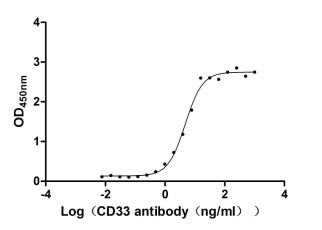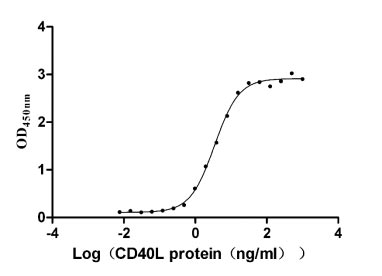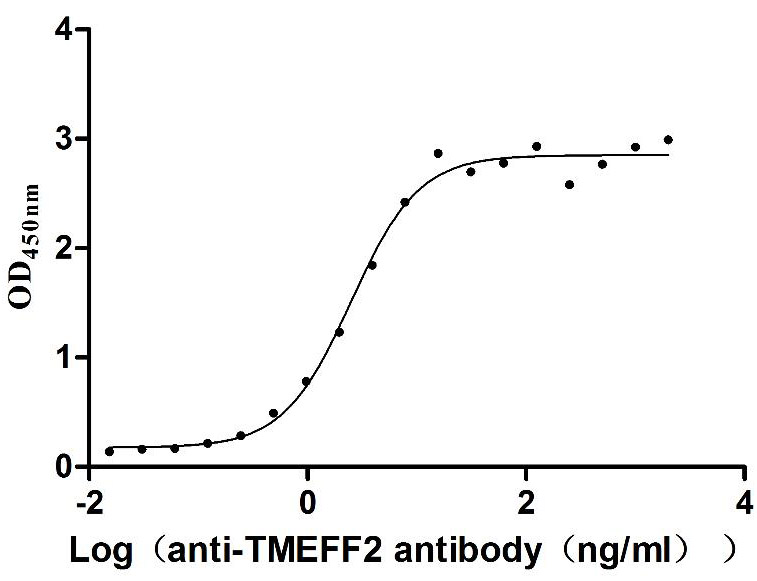Recombinant Mouse Guanine nucleotide-binding protein G (i) subunit alpha-2 (Gnai2)
-
货号:CSB-YP009589MO
-
规格:
-
来源:Yeast
-
其他:
-
货号:CSB-EP009589MO-B
-
规格:
-
来源:E.coli
-
共轭:Avi-tag Biotinylated
E. coli biotin ligase (BirA) is highly specific in covalently attaching biotin to the 15 amino acid AviTag peptide. This recombinant protein was biotinylated in vivo by AviTag-BirA technology, which method is BriA catalyzes amide linkage between the biotin and the specific lysine of the AviTag.
-
其他:
-
货号:CSB-MP009589MO
-
规格:
-
来源:Mammalian cell
-
其他:
产品详情
-
纯度:>85% (SDS-PAGE)
-
基因名:
-
Uniprot No.:
-
别名:Gnai2; Gnai-2Guanine nucleotide-binding protein G(i) subunit alpha-2; Adenylate cyclase-inhibiting G alpha protein
-
种属:Mus musculus (Mouse)
-
蛋白长度:Full Length of Mature Protein
-
表达区域:2-355
-
氨基酸序列GCTVSAEDK AAAERSKMID KNLREDGEKA AREVKLLLLG AGESGKSTIV KQMKIIHEDG YSEEECRQYR AVVYSNTIQS IMAIVKAMGN LQIDFADPQR ADDARQLFAL SCAAEEQGML PEDLSGVIRR LWADHGVQAC FGRSREYQLN DSAAYYLNDL ERIAQSDYIP TQQDVLRTRV KTTGIVETHF TFKDLHFKMF DVGGQRSERK KWIHCFEGVT AIIFCVALSA YDLVLAEDEE MNRMHESMKL FDSICNNKWF TDTSIILFLN KKDLFEEKIT QSSLTICFPE YTGANKYDEA ASYIQSKFED LNKRKDTKEI YTHFTCATDT KNVQFVFDAV TDVIIKNNLK DCGLF
-
蛋白标签:Tag type will be determined during the manufacturing process.
The tag type will be determined during production process. If you have specified tag type, please tell us and we will develop the specified tag preferentially. -
产品提供形式:Lyophilized powder
Note: We will preferentially ship the format that we have in stock, however, if you have any special requirement for the format, please remark your requirement when placing the order, we will prepare according to your demand. -
复溶:We recommend that this vial be briefly centrifuged prior to opening to bring the contents to the bottom. Please reconstitute protein in deionized sterile water to a concentration of 0.1-1.0 mg/mL.We recommend to add 5-50% of glycerol (final concentration) and aliquot for long-term storage at -20℃/-80℃. Our default final concentration of glycerol is 50%. Customers could use it as reference.
-
储存条件:Store at -20°C/-80°C upon receipt, aliquoting is necessary for mutiple use. Avoid repeated freeze-thaw cycles.
-
保质期:The shelf life is related to many factors, storage state, buffer ingredients, storage temperature and the stability of the protein itself.
Generally, the shelf life of liquid form is 6 months at -20°C/-80°C. The shelf life of lyophilized form is 12 months at -20°C/-80°C. -
货期:Delivery time may differ from different purchasing way or location, please kindly consult your local distributors for specific delivery time.Note: All of our proteins are default shipped with normal blue ice packs, if you request to ship with dry ice, please communicate with us in advance and extra fees will be charged.
-
注意事项:Repeated freezing and thawing is not recommended. Store working aliquots at 4°C for up to one week.
-
Datasheet :Please contact us to get it.
相关产品
靶点详情
-
功能:Guanine nucleotide-binding proteins (G proteins) are involved as modulators or transducers in various transmembrane signaling systems. The G(i) proteins are involved in hormonal regulation of adenylate cyclase: they inhibit the cyclase in response to beta-adrenergic stimuli. May play a role in cell division.
-
基因功能参考文献:
- In conclusion, Galphai2 deficiency in erythrocytes confers partial protection against suicidal cell death. PMID: 27499046
- This study reveals how RGS proteins modulate Galphai2 signaling to facilitate thymocyte egress and T cell trafficking. PMID: 28235863
- this study shows that Galphai2 controls arrest in response to chemokine stimulation of neutrophils PMID: 26976957
- In Galphai2-knockdown mice, they showed defects in social interaction, novelty recognition and active avoidance learning. PMID: 27787898
- Data show that inhibitory (Galphai2) and stimulatory (GalphasL) G-protein subunits produced minor atrophic and hypertrophic changes in muscle mass, and Galphai2 over-expression prevented AAV:beta2-adrenoceptor (beta2-AR) mediated hypertrophy. PMID: 26972746
- RGS proteins and Galphai2 play a significant role in regulating states of wakefulness, NREM sleep, and REM sleep PMID: 26564126
- Kinocilium is essential for proper localization of Lgn, as well as Gai and aPKC, suggesting that cilium function plays a role in positioning of apical proteins critical for hearing. PMID: 26662512
- Galphai2 deficiency combined with cardiac beta1-adrenoceptor overexpression strongly impaired survival and cardiac function, leading to dilated cardiomyopathy. PMID: 26464333
- An essential role for Galpha(i2) in Smoothened-stimulated epithelial cell proliferation in the mammary gland. PMID: 26373672
- Platelet Galphai2 not only controls hemostatic and thrombotic responses but also is critical for the development of ischemia/reperfusion injury in vivo. PMID: 25944935
- Data show that disrupting resistance to inhibitors of cholinesterase 8A (Ric-8A) expression in hematopoietic cells results in a loss of GTP-binding protein alpha subunits Galphai2, Galphai3, and Galphaq. PMID: 26232433
- Myocardial ischemia promptly regulated cardiac mRNA and with a slight delay protein levels of both Galphai2 and Galphai3, indicating important roles for both Galphai isoforms. PMID: 24858945
- RGS protein/Galphai2 interactions have an essential role in B lymphocyte-directed cell migration and trafficking. PMID: 25617475
- Data (including data from knockout mice) suggest that Gnai2 in islet beta-cells is necessary for up-regulation of insulin secretion in response to high glucose in presence of L-arginine or L-ornithine. PMID: 25205820
- The absence of Galphai2 and Galphai3 in B cells profoundly disturbs the architecture of lymphoid organs with loss of B cell compartments in the spleen, thymus, lymph nodes, and gastrointestinal tract. PMID: 23977324
- Galphai2(Q205L) regulates satellite cell differentiation into myotubes in a protein kinase C - and histone deacetylase -dependent manner PMID: 24298018
- Galphas- and Galphai2-mediated signaling in the sinoatrial node is important in the reciprocal regulation of heart rate through the autonomic nervous system. PMID: 23697798
- Galphai2-deficient mice spontaneously develop colitis and colonic neoplasms the severity of which are determined by the interplay between Th1 and Th2 cell pathways. PMID: 22962436
- Go2alpha protein subunit regulates axonal growth and branching and may increase Rap1GAP activity, thereby effecting the Rap1 activation/deactivation cycle. PMID: 23373526
- Galphai2 is required for endothelial neutrophil transmigration but not neutrophil chemotaxis and adhesion. PMID: 23225882
- These studies support our hypothesis that G-alpha(i2) proteins are novel negative regulators of Toll-like receptor activation. PMID: 22581266
- RGS proteins establish a threshold for Galpha(i2) activation, helping to coordinate desensitization mechanisms during inflammation. PMID: 22966200
- A quantitative study of the mechanisms behind thymic atrophy in Galphai2-deficient mice during colitis development. PMID: 22590596
- Galphai2 is an essential Galphai protein required for inflammation-induced migration of monocytes and macrophages in Galphai2- or Galphai3-deficient mice. PMID: 22706085
- analysis of Galphai2- and Galphai3-specific regulation of voltage-dependent L-type calcium channels in cardiomyocytes PMID: 21966394
- Demonstrate that signalling through Gai2 protects the heart from ischaemic injury and that this process is modulated by endogenous RGS proteins. PMID: 21349876
- Cecal ligation and puncture -induced plasma TNFalpha, IL-6, bacterial load in peritoneal fluid, blood and lung tissue and lung and liver MPO activity were significantly increased in Galphai2 (-/-) compared to WT mice. PMID: 21255617
- Variations in Gnai2 and Rgs1 expression affect chemokine receptor signaling and the organization of secondary lymphoid organs. PMID: 20508603
- Data suggest that Galphai-TNFAIP8-mediated rescue of pre-oncogenic cells enhances progression to oncogenic transformation, providing a selective target to inhibit cellular transformation. PMID: 20607800
- The absence of inhibitory G-protein signaling mediated through Galpha(i2) is a substrate for ventricular arrhythmias. PMID: 20495013
- G alpha i2(-/-) mice are deficient in B-1a B cells, splenic marginal zone B cells, and their immediate precursor, T2 B cells, with resultant in vitro functional deficiency in LPS-induced proliferation and IL-10 production. PMID: 12574334
- Gi2 has a role in regulating mitogenic activity in the neural progenitor cells of developing brain PMID: 15272018
- Alveolar macrophages use a Galphai2-dependent signal for modulating the two opposing Fc gamma receptors, FcgammaRIIB and FcgammaRIII, in the initiation of the inflammatory cascade in the lung Arthus reaction. PMID: 15728518
- Constitutively active Galphai2 occludes the transient suppression of synaptic transmission by mGluR2. PMID: 16606834
- Loss of Regulators of G protein signaling (RGS) actions at Galpha(i2) produces a dramatic and pleiotropic phenotype which is more evident than the phenotype seen for individual RGS protein knockouts. PMID: 16943428
- These data demonstrate that G(i2) and G(i1/3) proteins are both involved and differentially regulate splenocyte inflammatory cytokine and chemokine production in a highly Gi isoform specific manner in response to LPS and Gram-positive microbial stimuli. PMID: 16962188
- Galphai2 signaling events are not required for the development of the protective immune responses against S. stercoralis; however, Galphai2 is essential for the recruitment of neutrophils required for host-dependent killing of larvae. PMID: 17242370
- This study details distinct G alpha(i2) and G alpha(i3) effects on chemokine receptor CXCR3-mediated signaling. PMID: 17289675
- Gnai2 knockout mice show significantly reduced intestinal IL-11 production. Suggest MAP kinases, PGE2 and cAMP mediated signaling involved. PMID: 17332478
- specific Galpha(i2)-mediated signaling between endothelial cells and leukocytes is required for the extravasation of leukocytes and for tissue-specific accumulation PMID: 17360531
- Ghrelin attenuates glucose-induced insulin release via pertissigen-sensitive Galpha(i2)-mediated activation of potassium channels. PMID: 17575083
- Gnai2-deficient T cells exhibit significant defects in chemokine receptor signaling and illustrate how signals that modulate the level of Galphai2 present in lymphocytes directly affect the capacity of lymphocytes to respond to chemokines. PMID: 17579064
- Neutrophil Galpha(i2) is necessary for chemokine-induced arrest. PMID: 17699741
- Transgenic mice on a high fat diet which have this gene exhibit enhanced insulin sensitivity and increased glucose tolerance. PMID: 17928396
- results indicate that the upregulation of Gi2 in ischemic myocardium appears to be protective in inducing cell survival pathways to prevent myocyte death in response to ischemia/reperfusion injury PMID: 18316484
- Absence of either Galphai2 or Galphai3 significantly abrogated thymic homing, with an effect of Galphai3 being greater than that of Galphai2. PMID: 18501427
- These observations underscore interplay between Galphai2 and Galphai3 and potentially provide a novel strategy to prevent GVHD by blocking T cell homing at early stages and T effector cell trafficking at later time points. PMID: 18521956
- Report role of Gnai2 in the control of in vivo heart rate dynamics. PMID: 18832081
- In Galphai2(-/-) and interleukin-10(-/-) transgenic mice susceptible to immune-mediated colitis and inflammation-associated adenocarcinoma, similar levels of peripheral leukocyte and erythroblast genotoxicity were also observed. PMID: 19487293
- Young Gialpha2-/- colonic epithelium has normal MMR expression but selectively loses MLH1 and consequently PMS2 expression following inflammation. PMID: 19638594
显示更多
收起更多
-
亚细胞定位:Cytoplasm. Cytoplasm, cytoskeleton, microtubule organizing center, centrosome. Cell membrane. Membrane; Lipid-anchor.
-
蛋白家族:G-alpha family, G(i/o/t/z) subfamily
-
数据库链接:
KEGG: mmu:14678
STRING: 10090.ENSMUSP00000057543
UniGene: Mm.196464
Most popular with customers
-
Recombinant Human Myeloid cell surface antigen CD33 (CD33), partial (Active)
Express system: Mammalian cell
Species: Homo sapiens (Human)
-
Recombinant Human Tumor necrosis factor receptor superfamily member 5 (CD40), partial (Active)
Express system: Mammalian cell
Species: Homo sapiens (Human)
-
Recombinant Mouse Tyrosine-protein kinase Mer (Mertk), partial (Active)
Express system: Mammalian cell
Species: Mus musculus (Mouse)
-
Recombinant Human Cannabinoid receptor 1 (CNR1)-VLPs (Active)
Express system: Mammalian cell
Species: Homo sapiens (Human)
-
Recombinant Human Tomoregulin-2 (TMEFF2), partial (Active)
Express system: Mammalian cell
Species: Homo sapiens (Human)
-
Recombinant Human Interleukin-2 (IL2) (Active)
Express system: Mammalian cell
Species: Homo sapiens (Human)
-
Recombinant Human Killer cell immunoglobulin-like receptor 3DL2 (KIR3DL2), partial (Active)
Express system: Mammalian cell
Species: Homo sapiens (Human)
-
Recombinant Macaca Gastric inhibitory polypeptide receptor(GIPR), partial (Active)
Express system: yeast
Species: Macaca fascicularis (Crab-eating macaque) (Cynomolgus monkey)




















